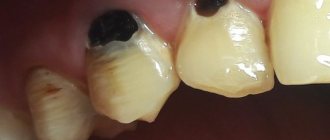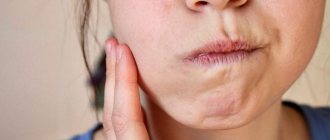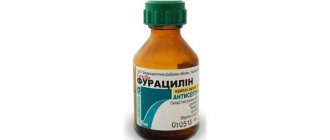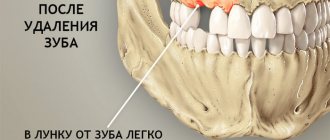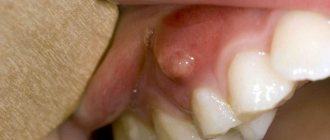Swelling in the mouth, the presence of painful ulcers and white plaque, inflammation of the gums and fever - all this may indicate the presence of stomatitis. This disease is diagnosed in patients of any age, and the fight against it often becomes difficult and lengthy. Dentists consider miramistin for stomatitis to be one of the best medicines. What is its peculiarity, how is the drug used correctly, and at what age is its use recommended?
How is stomatitis diagnosed?
The disease is manifested by the presence of inflammatory processes on the oral mucosa, which is caused by pathogenic microorganisms. Stomatitis has several forms of manifestation. Each of them has different symptoms. It depends on the reason for the development. One or another type of disease can be diagnosed based on the following symptoms.
- When stomatitis is of viral origin, the patient develops a high temperature. The oral mucosa becomes covered with ulcers. The lymph nodes, which are located in the lower jaw area, become enlarged. Very contagious.
- The traumatic origin of the disease is accompanied by swelling and soreness of the oral cavity. The child becomes whiny and refuses to eat. The temperature may rise in rare cases. This type of stomatitis is not contagious.
- With candidal stomatitis, the oral cavity is completely covered with a pronounced white coating. There is pain when eating. The temperature is rising. The disease is contagious.
- The bacterial type of disease is most often provoked by staphylococci and streptococci. At the beginning of its development, it manifests itself as redness and swelling of the gums. Next, the oral cavity becomes covered with ulcers, which cause a painful syndrome. Children may develop a fever. Fever is rare in adults.
- The allergic type begins with swelling and inflammation of the gums. Elevated temperature may not always be present. Easily turns into another form of stomatitis. For development, it will be sufficient for viral or bacterial agents to enter the oral cavity.
In addition to the types described above, so-called symptomatic stomatitis is sometimes diagnosed. It appears as a symptom of another disease.
Inflammation of periodontal tissues
The drug is used for antiseptic treatment of the oral mucosa during the treatment of gingivitis, periodontitis and periodontal disease. In combination with other measures (for example, taking antibiotics, brushing teeth from plaque and tartar, plasma lifting and injections of hyaluronic acid, bioactive gels), the product helps relieve inflammation and swelling of tissues, get rid of bleeding and increased sensitivity of the gums.
The drug is used for periodontitis
Types of stomatitis depending on age
Dentists note a certain pattern between the patient’s age and the type of stomatitis. Children are most often affected by the disease. This is due to the structural features of the child’s mucous membrane, which is formed gradually, and therefore has its own characteristic features.
- Children under one year of age often develop the fungal type (thrush). This is due to the slightly acidic or neutral reaction of saliva, which creates favorable conditions for Candida fungi.
- From one year to three years - the viral type. Saliva loses its protective properties. The content of lysozyme, a substance that fights pathogens, decreases.
- Until the age of seven, local immunity declines. The child becomes susceptible to a bacterial type of disease.
- The active development of immunity before the age of fifteen becomes the cause of an allergic type of stomatitis.
Most often, the medicinal antiseptic Miramistin is prescribed to combat stomatitis. Miramistin for stomatitis has proven itself well for patients of any age. The drug is approved for use from the first days of their life and for nursing mothers.
Rubbing with orthopedic and orthodontic devices
Most often, an unpleasant symptom occurs at the stage of getting used to the structures. Out of habit, orthopedic and orthodontic devices interfere, squeeze, rub and even injure the delicate tissues of the oral cavity, causing the appearance of various wounds, ulcers and chafing. During this period, it is very important to prevent pathogenic bacteria that cause an infectious inflammatory process from entering such wounds. It is necessary to promote rapid tissue healing and strengthen local immunity. Miramistin copes well with all its goals.
If the mucous membrane is damaged, Miramistin is also used
However, if you feel severe discomfort one or several months after starting to wear orthopedic and orthodontic devices, this may be due to improper installation, or a discrepancy between the selected and manufactured structures and your anatomical features. Here the drug will not help much, and to eliminate the problems you need to see a doctor.
Is Miramistin effective for stomatitis?
The drug has antimicrobial and bactericidal properties, destroying gram-negative and gram-positive microflora. Under the influence of Miramistin, the proliferation of fungi is inhibited, stopping the development of the disease. The medicine helps to form an adequate and correct immune response. As a result:
- local immunity significantly enhances its protective properties;
- the infection stops spreading to healthy tissue;
- already damaged tissues are restored faster;
- the drug helps to adsorb (collect) pus and remove waste products of pathogenic microorganisms;
- stops inflammatory processes.
Miramistin is available for sale in three forms: as a spray, solution and ointment. This helps the patient choose the most convenient option for using the drug.
A big advantage of the drug is its good compatibility with other antibiotics that are taken to increase tissue regeneration, as well as the taste of the drug. Many medications that are intended for treating the oral cavity are produced with an unpleasant taste. This becomes a problem when using them for children. Reflex vomiting and increased salivation can create a dangerous situation for the child’s health. Miramistin is distinguished by the absence of antipathetic odors and tastes. The solution is more similar in taste to plain water, which greatly simplifies the procedure for using it for children.
The drug is also suitable for preventive purposes when one of the family members already has the problem. To do this, the oral cavity is sprayed with Miramistin solution 2 times a day, but the drug cannot be used for more than 10 days.
The use of the drug does not always guarantee a positive result in treatment. Miramistin will not bring the expected result for allergic stomatitis. Treatment may fail if the disease is caused by dental problems. These include: the presence of periodontal disease or tartar, advanced caries, as well as the presence of other inflammatory processes. First you need to eliminate the original cause. Then just start fighting stomatitis.
Indications for use of Miramistin
Rinsing is often prescribed in the following cases:
- before extirpation (removal) of the tooth, inflammation (pulpitis, periodontitis) was diagnosed;
- the gums were additionally injured (for example, the gumboil was opened, drainage was installed to remove pus);
- There are sources of infection in the oral cavity (carious teeth, stomatitis, tartar, inflammation of the gums, etc.).
These factors significantly increase the risk of wound infection. You can prevent it by knowing how to rinse your mouth. This disinfects the hole, destroys pathogenic microflora, so the likelihood of developing complications is reduced. The main rule is that rinsing should not be too intense. Additionally, the doctor may prescribe antibacterial and anti-inflammatory non-steroidal drugs.
Rinsing is often useful after wisdom tooth removal, since the procedure is traumatic. Eights grow normally only 20% of the time. In 8 out of 10 patients, wisdom teeth are removed at the eruption stage. Due to the peculiarities of their incorrect placement, the tissues are severely damaged, so the recovery period is delayed. Rinsing allows you to speed it up.
Side effects and contraindications
Side effects from using the drug include the risk of developing an allergic reaction. It occurs very rarely and most often affects young patients. A burning sensation may occur during use. This phenomenon is considered normal and does not require refusal from further use.
Contraindications include individual intolerance of the body to the components of the drug, which occurs in the presence of certain types of allergies and dermatitis. In any case, Miramistin should be taken under the supervision of a specialist.
Comments
Miramistin is really good, but it’s just expensive, almost 400 rubles for 150 milliliters. What is the best way to replace it?
Cherkassova Dilyara (09.10.2020 at 23:29) Reply to comment
- Dear Dilyara, in terms of the principle of action and set of positive properties, budget drugs such as Chlorhexidine and Furacilin are similar to Miramistin. But before using them, do not forget to consult your doctor, because they have a number of contraindications.
Editorial staff of the portal UltraSmile.ru (10/13/2020 at 09:14) Reply to comment
Write your comment Cancel reply
Use of the drug for children
Miramistin can be used from the first weeks of a baby’s life, but since a baby at this age will not yet be able to rinse his mouth, a special spray nozzle is used. Using a spray, lesions of the mucous membrane are treated with a single press. The procedure is repeated 4 times/day. Until the child is four years old, you should avoid getting the medicine deep into the neck and onto the tonsils. The effectiveness of the drug can be increased. To do this, you will need to create an alkaline environment in the oral cavity. For these purposes, rinse with a soda solution. The solution is made from a glass of water and a teaspoon of soda.
Miramistin, which is available in gel form, showed good results. Staying on the mucous membrane for a long time, the gel effectively penetrates into the deep layer of the mucous membrane. To apply the drug, you can use a gauze swab and wipe the inflamed areas.
Miramistin ointment is less effective for children. It is quickly washed off by the baby’s saliva and is not able to penetrate into the deeper layers.
Sanitation may be prescribed to a child who can rinse his mouth independently. The product is diluted with boiled, cooled water in a 1:1 ratio. Age dosage:
- less than 6 years – 3..6 ml;
- up to 12 years – 6..10 ml;
- over 14 years old – 15 ml.
The procedure is repeated up to six times a day.
How to rinse your mouth with Miramistin after tooth extraction
In the first 1–2 days after extirpation, any rinsing is prohibited. Otherwise, you can wash the clot out of the well. If an infection gets into it, alveolitis or osteomyelitis will begin. In the first case, the socket becomes inflamed, in the second – the bone. That's why they only do baths. Take one sip (10–15 ml) of liquid at room temperature into your mouth, hold it for 1–2 minutes and spit it out.
Next, you should adhere to the following rules:
- Starting from the 3rd–4th day, you can carry out gentle rinsing. To do this, you need to tilt your head several times from the side of the extracted tooth to the healthy one.
- Baths and rinses are carried out immediately after meals.
- After treating the oral cavity with Miramistin for 1–1.5 hours (optimally up to two), you should refrain from smoking, drinking and eating.
In most cases, patients are prescribed 3-4 rinses per day. The course of treatment is up to a week.
After tooth extraction, patients should also pay special attention to oral care. If you are concerned about whether it is possible to do ordinary hygienic rinses, then you should also avoid them at first. In order to maintain hygiene, patients are recommended to use the same baths. To do this, take warm water into your mouth, hold it a little and spit it out. And so several times until you feel fresh.
Miramistin for adults
Adults, as well as children over 14 years of age, with stomatitis, choose any suitable option for treating damaged areas of the mucous membrane. This can be either rinsing with a solution or simply irrigating with a spray. For one rinsing procedure, 15 ml of an undiluted solution (0.01%) of Miramistin is used. This solution is commercially available ready-made. Additional manipulations for its dilution or preparation are no longer required.
The course of treatment lasts an average of 7 days, 4 procedures per day. The procedures should be carried out regularly at approximately equal intervals in time. Maintaining time intervals will help achieve more effective results. The drug is quickly washed off by saliva, so a long time without it reduces the therapeutic effect.
During administration, in places where the drug comes into contact with damaged areas of the mucous membrane, a slight burning sensation may be felt. The sensation goes away after a few seconds and is not a reason to discontinue the drug.
A few words about the history of the creation of the drug
"Miramistin" as a drug first began to be developed in the distant 70s. At first, it was promoted as a composition that was supposed to be used at interorbital stations to disinfect the skin of astronauts and to treat objects, things, and workplaces around them. However, after the collapse of the USSR, research on the active antiseptic substance miramistin was suspended; they were returned to them again in the late nineties. It was then that the medicine first began to be put on sale, but to solve narrow-profile problems (for example, the prevention of sexually transmitted diseases). There was no talk of him as a child at all.
Miramistin allows you to solve problems in many areas of medicine
Later, additional studies were carried out, which allowed specialists to expand the list of areas of application of the drug. And its safety, almost one hundred percent effectiveness and the absence of contraindications, except for individual intolerance, made it possible to use Miramistin for children.
Today the drug is produced by a production facility located in the Moscow region. The medicine is in demand in Russia, Ukraine, Belarus, Kazakhstan, Turkmenistan, and Armenia. They also plan to sell the product in China soon1.
Now let’s look at the cases in which doctors at dental clinics recommend using the drug. You need to understand that Miramistin is equally often prescribed in both pediatric and adult dentistry as an additional measure to the main treatment. It is not a panacea, but the instructions for its use state that, in combination with other measures, it helps get rid of various problems.
Miramistin for gum inflammation
Miramistin is often used for gum inflammation, which manifests itself as a symptom of various dental ailments. The drug has proven itself in complex treatment, where it is used to rinse the mouth. To obtain the most positive result from the rinsing procedure, you need to properly prepare the gums and mucous membranes. This is done as follows:
- The oral cavity is thoroughly cleaned with conventional hygiene products (brush, dental floss and toothpaste). This will make it possible to eliminate plaque and food debris from all hard-to-reach places where the drug should subsequently reach.
- The drug will give a positive effect faster if you increase blood circulation. To do this, you should massage your gums. It is done using the thumb and index finger. The gums are massaged using massage movements for five minutes. For massage, you can use a paste containing medicinal herbs or a drop of essential oil.
- After the massage, the oral cavity is rinsed with water at room temperature (in cases where additional products were used).
Further, all rinsing procedures occur in the order prescribed by the doctor.
In dentistry, Miramistin is also used for the treatment of periodontitis, for hygienic procedures for removable dentures, and also as an effective means for the prevention of microbial complications that may arise after surgical interventions on the oral mucosa.
Sources used:
- “Outpatient surgical dentistry” (Bezrukov V.)
- Miramistin. Collection of works / Ed. Yu. S. Krivosheina. - M., Medical Information Agency, 2004.
- Miramistin. Encyclopedia of medicines and pharmaceutical products. Radar Patent.





